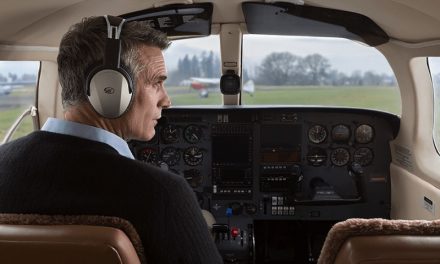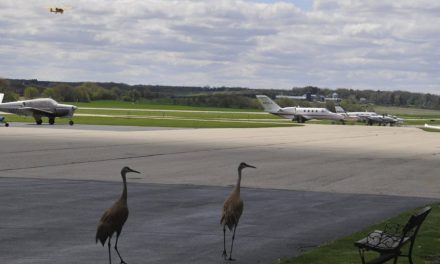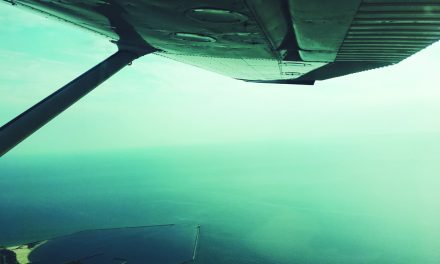Far from menacing monsters, mountains can be your best friends.
The Pan American Highway threads its way steeply uphill out of Santiago, Chile, climbing into the rarified air of South America’s high Andes. The road rises with the terrain, slowly ascending through switchbacks and turnabouts until someone noticed that a conventional highway was becoming impractical, so they built a tunnel.
Unfortunately, airplanes can’t use tunnels. Just as well, because tunnels have no magic—but mountains do. As I look straight east at the solid rock ridge that seems taller than I could possibly fly in a poor, defenseless, Cessna 207, I marvel at the sheer poetry of the mountains.
In fact, poetry prevails in the Andes, from Caracas at the top of the continent to Tierra del Fuego at the bottom. Here in the middle, I can see the high foothills of Cerro Aconcagua as it reaches for the flight levels. As I struggle through 11,000 feet, I’m not even half as tall. Aconcagua is the highest peak in the Western Hemisphere, piercing the clouds to an elevation of nearly 23,000 feet. And I thought McKinley was big!
There’s little relief on the south side of the pass. Cerro Tepungato, the Andes’ second highest mountain at 21,500 feet, guards the southern approach, jealous of my artificial altitude and determined to be bigger than I am. It wins.
Back in 1972, somewhere to the south of Tepungato, a twin turboprop carrying a Uruguayan rugby team crashed in the high mountains. Somehow, 16 survivors overcame incredible odds to live 72 days in the high, cold air before being rescued. This is the portal through the High Andes between Chile and Argentina, a hard rock, unforgiving V of granite, grudgingly allowing only some of those who dare to pass unmolested. There is no malevolent or mysterious accident triangle here. Nor is it a place where devils or dragons reside. But, it is a region of thin air and sometimes violent weather, often terribly unforgiving of any mistake.
The mountains taper down to a series of high hills 300 miles south, but no, I have to do it the hard way. I struggle to surmount the lowest point of the ridge, wave soaring with condors for more altitude. The walls of the pass, I’m told, feature occasional reflections from aluminum airplane parts, once attached to living, breathing Cessnas, Pipers, Fairchilds, and DeHavilands, but now memorials to others who weren’t so fortunate as I hope to be.
And yet, despite the high rocks’ disapproving, ominous frowns, looking down on me from four-mile heights, there is a kind of beauty to these semi-vertical edifices. I suppose my real appreciation stems from having been raised in Alaska and New Mexico where mountains dominate practically every horizon and to have subsequently lived around them most of my life.
I spent my teenage years in Anchorage and used to look north on those bitingly cold, incredibly clear, winter days and see the dramatic white dome of McKinley peeking over the horizon, shining in the sun from 170 miles away. Unlike the jagged blades of rock that form Everest and Annapurna, McKinley always seemed benign and friendly, a happy, rounded marshmallow of a mountain. With the typical arrogance of youth, I used to think, “Perhaps I’ll take a stroll up the side of it some afternoon,” not knowing that Denali (the Indian name for it) is infamous in the climbing community for some of the worst weather conditions of any mountain.
Later, 2500 miles south in Albuquerque, I lived hard by the peaks of Sandia, and still later in Southern California, I flew the length of the Owens Valley, staring up at Mt. Whitney and marveling at the majesty of the jagged Sierra Nevada. There were times when the rising terrain fostered wild up and down drafts, and my love for tall rocks was tempered by gritted teeth and seat belts pulled as tight as I could get them.
Still, there was always the wonderful, Sheepherder bread of Schat’s Bakery in Bishop to look forward to. I used to fly my first airplane, a Globe Swift, 200 miles to Bishop just for the great bread—a $100 loaf rather than the proverbial hamburger, if you will. It seemed worth it at the time. I hope Schat’s is still there.
Some pilots regard mountains as the enemy, but I’ve always considered them friends. Learn to read them. Envision the wind flowing across them like water cascading over rocks in a stream, fly the appropriate slope, and you may be able to appreciate free climb or tailwinds.
High terrain can also serve as a buffer to help hold bad weather at higher elevation and provide room to fly underneath. When the weather is good, mountains can serve as navigation beacons for hundreds of miles. McKinley stands like a sentinel practically in the middle of Alaska. When visibility is good, you can see the perpetually white, mushroom peak from 200 miles away in all directions. That’s because the base of Denali starts at relatively low altitude, whereas Everest begins from a plateau that’s already 13,000 feet high.
Once, 25 years ago during a bright, chamber-of-commerce, September morning, I was flying a Piper Cheyenne III from Anchorage to Pt. Barrow. Looking down in air as clear as Chablis and as smooth as sable, Denali was looking back, benign and spectacular, with no telltale plume of snow blowing off the top, suggesting light winds and smooth air at the peak.
I couldn’t resist the temptation, so I asked Anchorage Center if I could drop down and skim across the muscular, snow-capped peak. Never mind all the regulations about IFR and VFR and positive control airspace, what I thought was an original idea was apparently old hat to the controller, as he immediately approved my deviation in the most bored voice possible.
The air was dead calm as I leveled at 20,500 feet, 200 feet above the summit. It wasn’t Everest, and I didn’t imagine I was Col. Robert Scott of the Flying Tigers, buzzing the world’s tallest mountain in 1942, but it was still a thrill. (For details, read Scott’s book, “God Is My Copilot”.)
In the Southwest U.S., Navajo Mountain, a huge, bulbous hillock of rock east of Page, Arizona, also serves as a waypoint for pilots. It’s only about 10,300 feet tall, but it stands all alone at the north end of the Painted Desert, 5000 feet above local terrain. You can spot it from any direction for 100 miles.
Traveling along the West Coast in clear conditions, you can fly north with a series of huge mountains as guideposts. In Northern California, there’s Mt. Shasta; then, the Three Sisters and Mt. Hood in Oregon; Mt. St. Helens and Mt. Rainier in Washington pointing the way to Seattle, and, finally, Mt. Baker on the Canadian border near Vancouver. I’ve only seen the full panoply of volcanos two or three times in 40 years of flying, but it’s nothing short of splendiferous.
On this day in December, my passage across the Andes is anticlimactic, if that’s even possible amidst such a magnificent display of topography. I clear the pass into Argentina without incident, following the advice of my condor friends. They soar effortlessly above me and watch my loud, comparatively ugly, awkward metal beast struggling to match their simple grace.
Overloaded and almost tapped out of climb, my Cessna finally skims a few hundred feet above the lonely, metal, Chilean research station built directly on the nadir of the pass, and I fly out into the huge valley above Mendoza, Argentina, with the Patagonian Desert to my right. How could anyone not love mountains?
These days, the mountains’ value as navigation waypoints has been diminished. Pilotage has become a lost art and dead reckoning is now automatic with a $500 GPS. Though satellites may have relegated the art of navigation to a few keystrokes, mountains can still highlight a route and provide comfort to help you recognize the hills of home.





